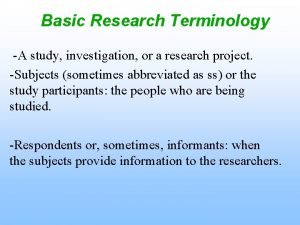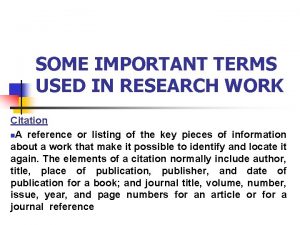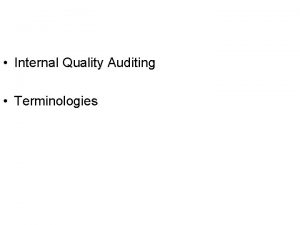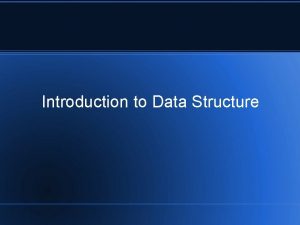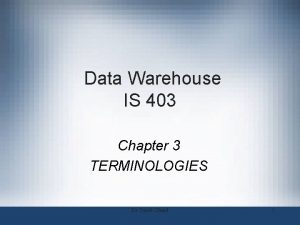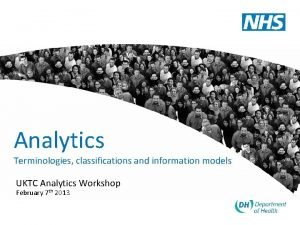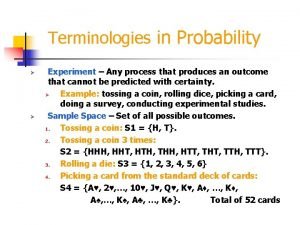Analysis of data Terminologies Data Data is the








































- Slides: 40

Analysis of data


Terminologies • Data: Data is the pieces of information obtained in a study. – Information in raw or unorganized form (such as alphabets, numbers, or symbols) that refer to, or represent, conditions, ideas, or objects. • Data entry: the process of entering data onto ana input medium for computer analysis. • Data transformation: a step often undertaken before data analysis to put the data in a form that can be meaningfully analysed (eg: recoding of values).


• Qualitative research: the investigation of the phenomena, typically in an in depth and holistic fashion through the collection of rich narrative materials using a flexible research design. • Qualitative data: information collected in narrative form, such as dialogue from a transcript of an unstructured interview • Qualitative analysis: The organization and interpretation of narrative data for purpose of discovering important underlying themes, categories and pattern of relationship

• Quantitative research: the investigation of phenomena that lends themselves to precise measurement and quantification often involving a rigorous and controlled design. • Quantitative data: information collected in numerical form. • Quantitative analysis: the manipulation of numeric data through statistical procedures for the purpose of describing phenomena or assessing the magnitude and reliability of relationships among them.

• Qualitizing: the process of reading and interpreting quantitative data in a qualitative manner • Quantitizing: the process of coding and analysing qualitative data quantitatively


• Data collection is followed by analysis and interpretation of the data • Where collected data are analysed and interpreted in accordance with the study objectives. • Analysis and interpretation includes – Compilation – Editing – Coding – Classification – And presentation of data

Analysis of data is a process of inspecting, cleaning, transforming, and modeling data with the goal of discovering useful information, suggesting conclusions, and supporting decision-making.

• Analysis is a process of organizing and synthesizing the data so as to answer research questions and test hypothesis. • Analysis is the process of breaking a complex topic into smaller parts to gain better understanding of it.

• Analysis and interpretation follows different path for – Qualitative data – Quantitative data

Analysis of quantitative data

Steps of quantitative data analysis 1. Data preperation(cleaning and organizing data for analysis 2. Describing the data 3. Drawing the inferences of data(inferential ststistics) 4. Interpretation of data

Data preperation(cleaning and organizing data for analysis Steps • Compilation • Editing • Coding • Classification • tabulation

Describing the data • (Descriptive or summary statistics) • Describes basic feature of the data and summarizes about the sample and the measures used in the study • Examples: Percentages, Means of central tendency(mean median mode) and means of dispersion(SD, Range, Mean deviation)

Drawing the inferences of data • Inferential statistics • Inferences i. e finding of differences relationships and association between two or more variables • With the help of parametrc and no parametric test • Commonly used are z test, t test, chi square test, ANOVA etc…. .

Interpretation of data • It has to be done carefully • It is a critical thinking activity done through brainstorming to infer the condensed and statistically computed data so that research question can be answered and hypothesis can be tested. • Helps in recommendation of the study

• It is a subjective activity • Not gaurded with scientific methods and procedures • It is liable to bias and errors

Interpretation process Analysed study result -tables - Graphs -Statistical computations Careful critical examination of the study Drawing the comparitive and contrast relationships



WHAT IS DESCRIPTIVE STATISTICS? Descriptive Statistics is a method of organizing, summarizing, and presenting data in a convenient and informative way to draw meaningful interpretation. The actual method used depends on what information we would like to extract.

classification • • Measures of condensed data Measures of central tendency Measures of dispersion Measures of relationships

Measures to condense data Quantitative data are generally condensed and presented through tables, chats, graphs and diagrams.

tables • Table is a tabular representation of statistical data • Tabulation is the first step • Tabulation means systematic presentation of the information contained in the data in rows and columns in accordanc ewith some common features and characteristics • Rows are horizontal and column are vertical

General principles of tabulation

Objectives of tabulation • • • To summarize data systematically To clarify data on simple To facilitate for comparitive study To present data in a minimum step To give identity to data

Parts of table • • Table number Title Subheads Caption and stubs Body of the table Footnotes Source note

Table 1: title (sub heads) captions Column heading Body of the table Stubs Row heading Foot note Source note

Types table • • Frequency distribution table Contigency tables Multiple response tables Miscellaneous tables

Graphs 6 5 4 Series 1 3 Series 2 Series 3 2 1 0 Category 1 Category 2 Category 3 Category 4

• • • Simple bar diagram Multiple bar diagram Pie diagram Histogram Frequency polygon Line graphs Cumulative frequency curve Scattered or dotted diagram Pictogram Map diagram

Measures of central tendency • • • Mean Median Mode Geometric mean Harmonic mean

Normal probability curve

Corelation coefficient • Karl pearson’s correlation coeeficient • Spearmans correlation coefficient

Inferential statistics • The sample is a set of data taken from the population to represent the population. Probability distributions, hypothesis testing, correlation testing and regression analysis all fall under the category of inferential statistics.

• • • Type I error: Type II error: Level of significance: Confidence interval Degree of freedom Test of significance

Test of significance • Parametric test: t test, z test, ANOVA etc • Nonparametric test: chi square test, median test, Mc. Nemar test

Computer analysis of quantitative data • • Microsoft excel SPSS- statistical package for social sciences SAS- statistical analysis system Minitab
 Itsm terms and terminologies
Itsm terms and terminologies Ethical hacking terminologies
Ethical hacking terminologies Security terminologies and principle
Security terminologies and principle Basic research terminologies
Basic research terminologies Dominant trait quiz
Dominant trait quiz In text citation with more than one author
In text citation with more than one author Hình ảnh bộ gõ cơ thể búng tay
Hình ảnh bộ gõ cơ thể búng tay Frameset trong html5
Frameset trong html5 Bổ thể
Bổ thể Tỉ lệ cơ thể trẻ em
Tỉ lệ cơ thể trẻ em Gấu đi như thế nào
Gấu đi như thế nào Tư thế worm breton là gì
Tư thế worm breton là gì Alleluia hat len nguoi oi
Alleluia hat len nguoi oi Môn thể thao bắt đầu bằng từ chạy
Môn thể thao bắt đầu bằng từ chạy Thế nào là hệ số cao nhất
Thế nào là hệ số cao nhất Các châu lục và đại dương trên thế giới
Các châu lục và đại dương trên thế giới Cong thức tính động năng
Cong thức tính động năng Trời xanh đây là của chúng ta thể thơ
Trời xanh đây là của chúng ta thể thơ Cách giải mật thư tọa độ
Cách giải mật thư tọa độ Làm thế nào để 102-1=99
Làm thế nào để 102-1=99 độ dài liên kết
độ dài liên kết Các châu lục và đại dương trên thế giới
Các châu lục và đại dương trên thế giới Thơ thất ngôn tứ tuyệt đường luật
Thơ thất ngôn tứ tuyệt đường luật Quá trình desamine hóa có thể tạo ra
Quá trình desamine hóa có thể tạo ra Một số thể thơ truyền thống
Một số thể thơ truyền thống Cái miệng xinh xinh thế chỉ nói điều hay thôi
Cái miệng xinh xinh thế chỉ nói điều hay thôi Vẽ hình chiếu vuông góc của vật thể sau
Vẽ hình chiếu vuông góc của vật thể sau Nguyên nhân của sự mỏi cơ sinh 8
Nguyên nhân của sự mỏi cơ sinh 8 đặc điểm cơ thể của người tối cổ
đặc điểm cơ thể của người tối cổ Thứ tự các dấu thăng giáng ở hóa biểu
Thứ tự các dấu thăng giáng ở hóa biểu Vẽ hình chiếu đứng bằng cạnh của vật thể
Vẽ hình chiếu đứng bằng cạnh của vật thể Tia chieu sa te
Tia chieu sa te Thẻ vin
Thẻ vin đại từ thay thế
đại từ thay thế điện thế nghỉ
điện thế nghỉ Tư thế ngồi viết
Tư thế ngồi viết Diễn thế sinh thái là
Diễn thế sinh thái là Các loại đột biến cấu trúc nhiễm sắc thể
Các loại đột biến cấu trúc nhiễm sắc thể Số.nguyên tố
Số.nguyên tố Tư thế ngồi viết
Tư thế ngồi viết Lời thề hippocrates
Lời thề hippocrates



